Family : Batrachoididae

Text © Giuseppe Mazza

English translation by Mario Beltramini
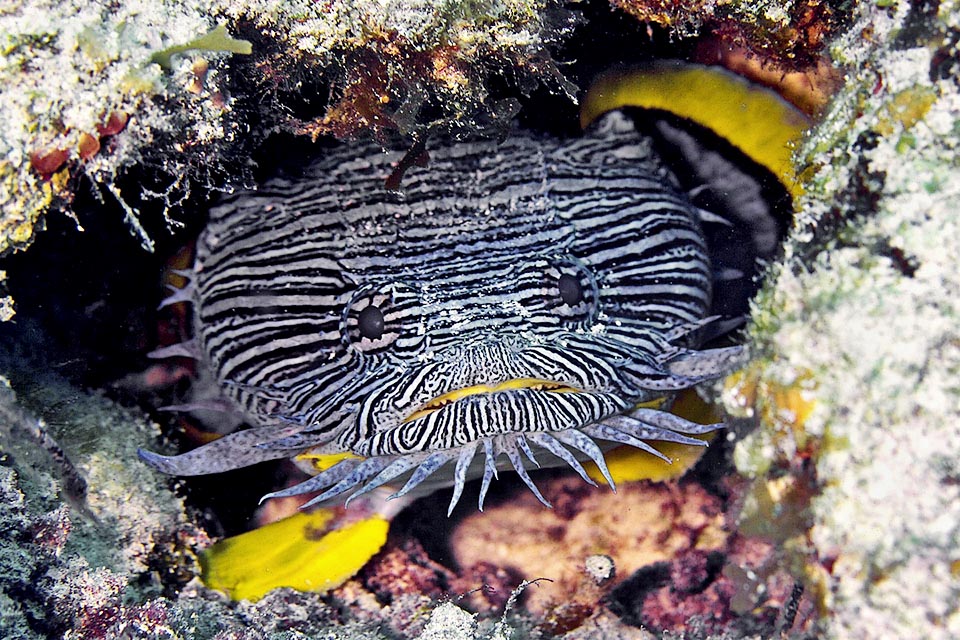
Described only in 1974, the Splendid toadfish (Sanopus splendidus) appears as “Vulnerable” in the IUCN Red List of the endangered species © Allison & Carlos Estape
Known as Splendid toadfish or Coral toadfish Sanopus splendidus Collette, Starck & Phillips, 1974, is a species described only in recent times.
Belonging to the class of Actinopterygii, the ray-finned fishes, to the order of Batrachoidiformes, and to the family of Batrachoididae, the so-called toadfishes with the naked body, usually brownish grey, sometimes covered by small cycloid scales, the massive head and the wide mouth.
This unusual group has been nowadays divided into three subfamilies: Batrachoidinae, Porichthyinae and Thalassophryninae.
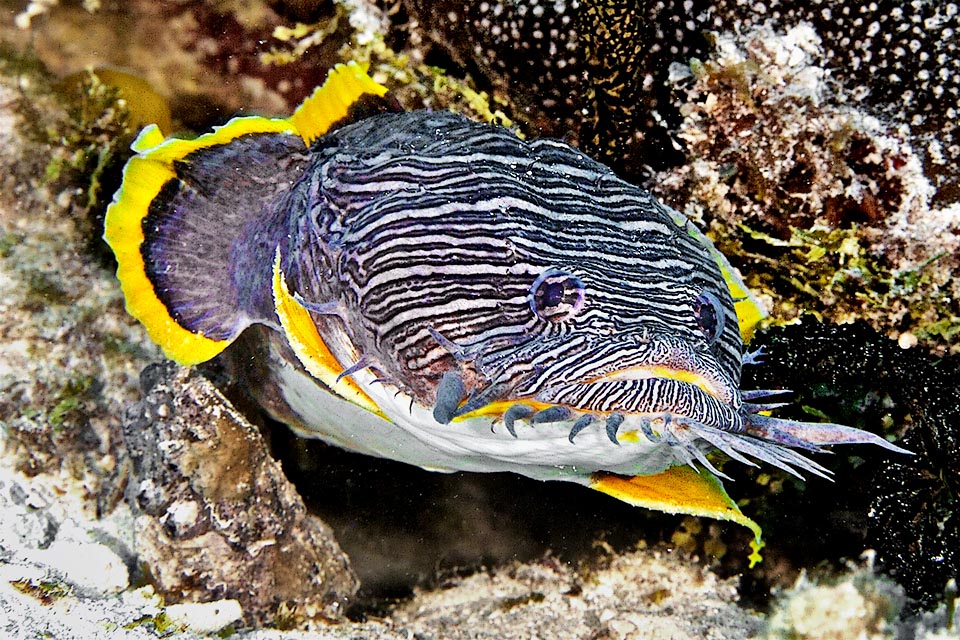
Apart habitat degradation, it’s in fact a species with its range reduced to Cozumel Island in Mexico and Glover’s Reef off Belize © Allison & Carlos Estape
Sanopus splendidus, the most colourful of the group, belongs to the Batrachoidinae, that count about 18 genera, 47 species scattered in the world and some members in the fresh waters.
The Porichthyinae, characterized by the presence of photophores that enlighten the lateral lines, count 2 genera and 15 marine species present in the American continent.
The Thalassophryninae, with their hollow the poisonous spines on the dorsal fin and the opercula, are the ill-famed poisonous toads. They are also American with freshwater species in South America count 25 genera and 78 species.
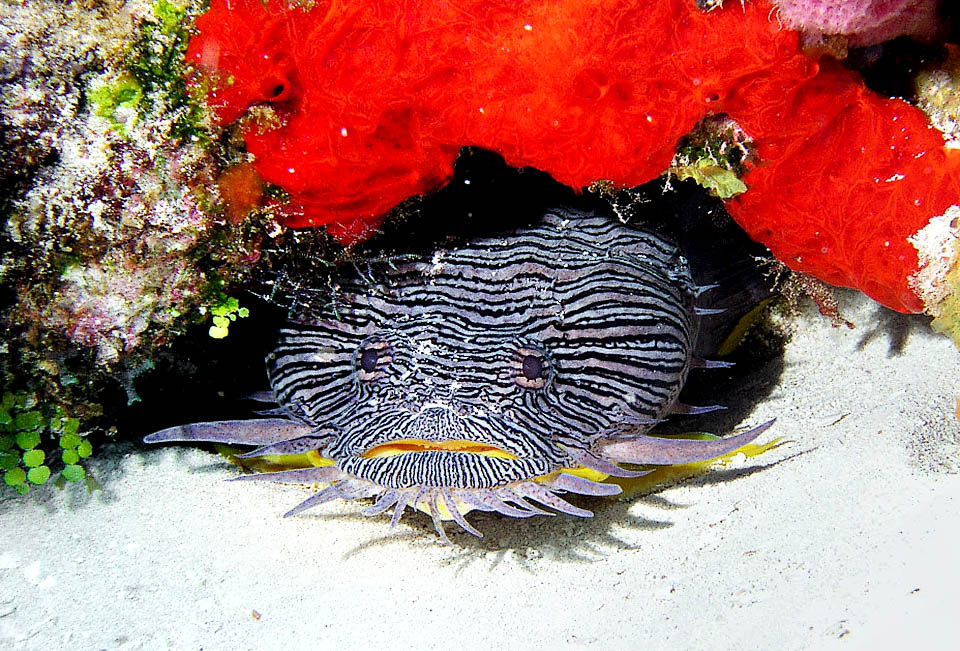
It’s usually found from 10 and 15 m of depth, while peeking with its wide and flat head from small caves under the cotrals © Mark Rosenstein
The term Sanopus, the Authors having said nothing, could arise from the anagram of the genus Opsanus, an old member of the group described by Linnaeus as Gadus tau and presently known as Opsanus tau (Linnaeus, 1766).
There are no doubts for the specific term splendidus, splendid in Latin, due to the elegant livery.
Zoogeography
Sanopus splendidus has a very reduced distribution area, endemic to the island of Cozumel, Mexico and Glover’s Reef off Belize.
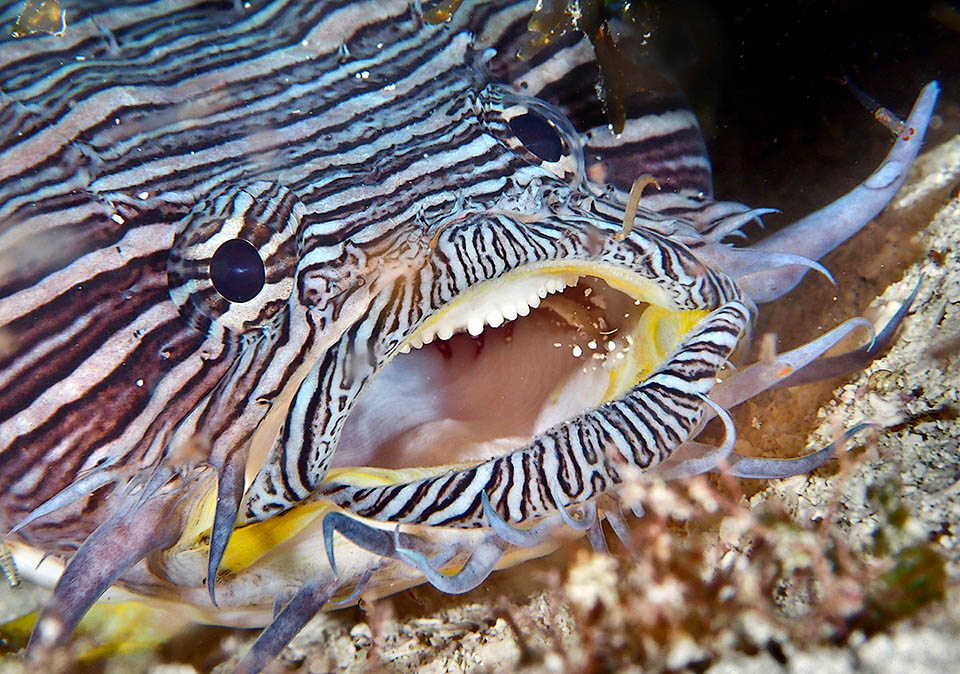
It’s a coastal benthic species feeding on small fishes, gastropods and polychaetous worms. The huge mouth is armed with small sharp teeth © Florent Charpin
Ecology-Habitat
It is a coastal benthic species present in madreporic environment between 8 and 25 m of depth, but that usually peeks out from small grottoes under the corals from 10 to 15 m.
Morphophysiology
Sanopus splendidus may reach the length of 24-29 cm.
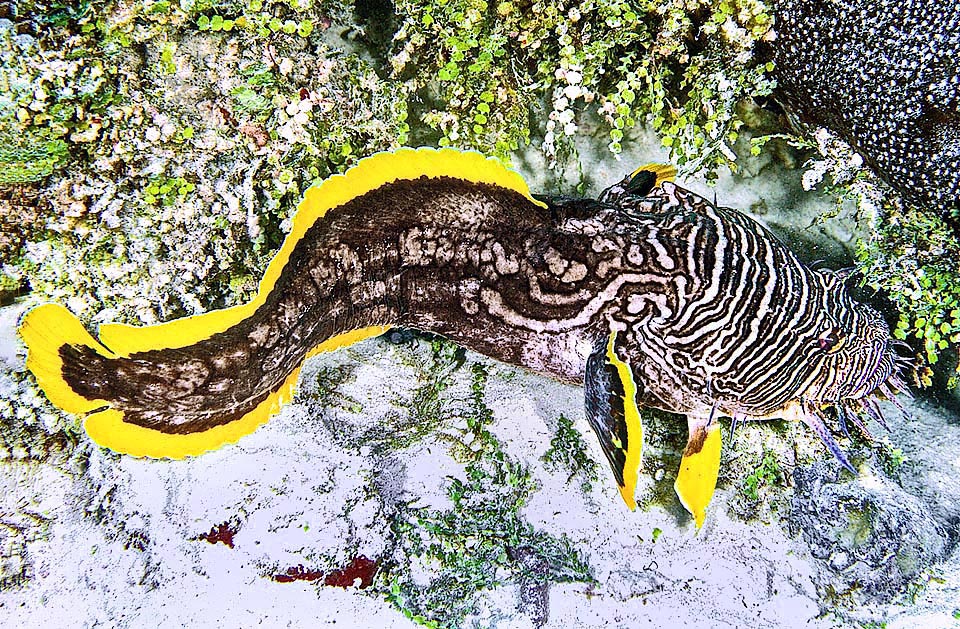
The livery is embellished by the bright yellow-orange edge of the fins. After the massive zebra head the sides display the drawing of a link chain not always evident © Allison & Carlos Estape
The head is wide and flat with sometimes ramified small barbels. These are particularly enlarged on the lower jaw. Only 1 or 2 on the chin appear ramified at the base.
The mouth, huge, displays little sharp teeth.
The eyes, located on the top of the head, look upwards because they are fishes that usually do not need a horizontal sight. Close to these stand two tubular nostrils and the fish gathers information from the surrounding environment also through a double lateral line. The upper one has 30-34 papillae and the lower 28-30.
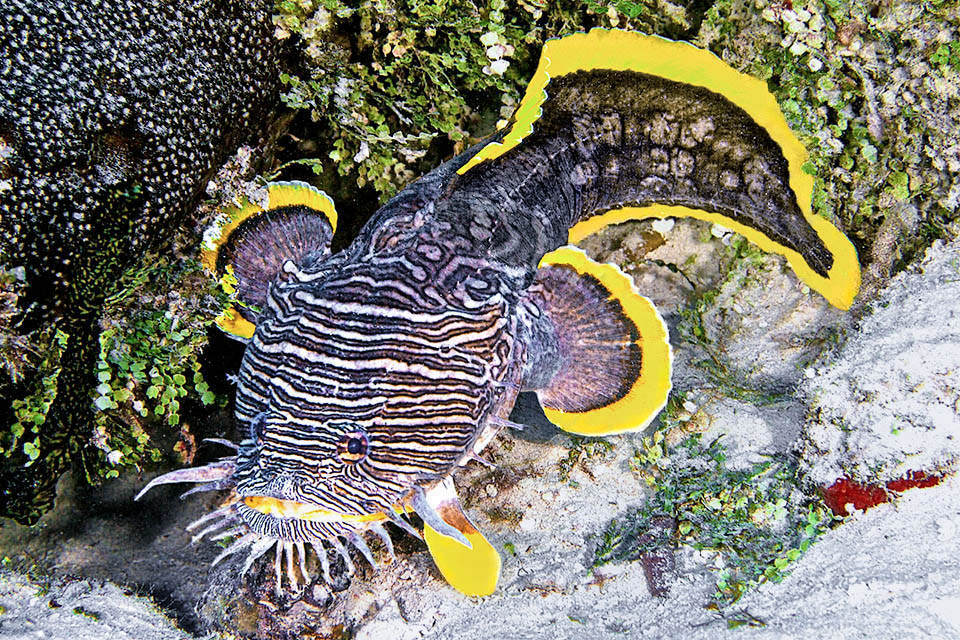
The pelvic fins, very advanced, are completely golden and here can be seen well on the body the two lateral lines rich in sensors © Allison & Carlos Estape
The dorsal fin has 3 spiny rays and 29-31 soft, the anal, spineless, has 25 rays.
The pelvic fins are decidedly standing forward, much before the big pectoral fins that have at their base the gill opening protected by an operculum with a spine at the upper corner and another below.
The pelvic fins are of bright orange-yellow colour and the same showy colour is found on the ample edge of the other fins preceded by a little black border. For the rest, the livery is greyish with a small pattern having clear lines, at times similar to the links of a chain, whilst the head has white and black stripes.
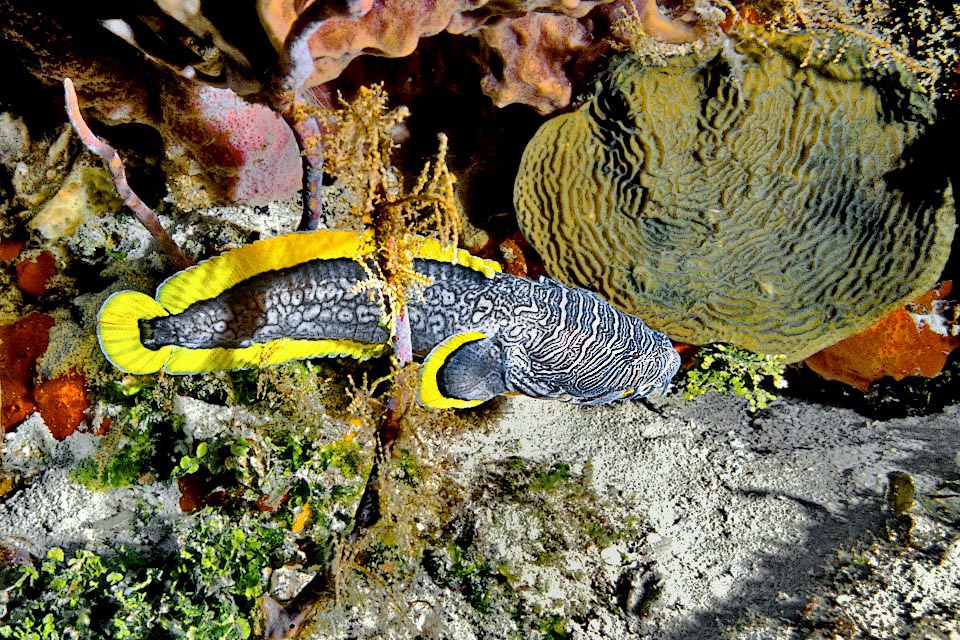
The fecundated eggs are often stuck to the walls of the caves and surveyed by the male. Once consumed the yolk sac the larvae disperse crawling on the seabed © Pauline Walsh Jacobson
Ethology-Reproductive Biology
Sanopus splendidus feeds on small fishes, gastropods and polychaetous worms.
For mating it seems that it emits a recalling buzz that can be heard by the divers. The fecundated eggs, sticky, are often glued to the walls of the small caves and surveyed by the male. The larvae keep together in this sort of nest till when they have consumed the yolk sac and then disperse by crawling on the seabed among the corals. Unfortunately, therefore, is missing that pelagic phase that would allow the diffusion of the species and the genetic exchange between the various populations.
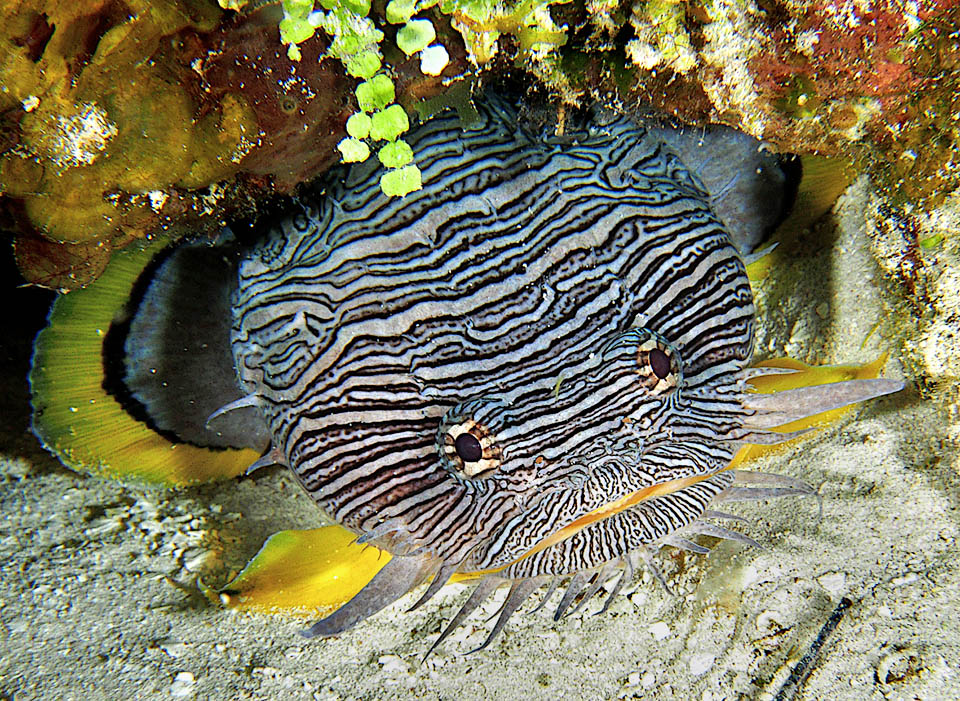
And this is the major limit of Sanopus splendidus, because missing the pelagic phase, the offspring cannot go far, as usually is the case with other fishes, to conquer new coasts. The range does not increase, and despite the sound call that precedes the matings there is no genetic exchange between the populations © Florent Charpin
The resilience of Sanopus splendidus is mediocre with a possible doubling of the members in 1,4-4,4 years and the fishing vulnerability, very low, marks only 10 on a scale of 100.
However, the Splendid toadfish appears in the IUCN Red List of the species at risk as “EN, Endangered” due to the poor diffusion and the habitat alteration caused by man with the increasing tourism in the sites where they live.
The mangroves formations are destroyed and the coasts are reshaped in order to create room for the cultivations and the dwellings with agrochemical and domestic pollution, not to forget the direct impact of the tourists with the coming and going of boats that anchor among the corals thus causing damages to the reef.
→ For general information about FISH please click here.
→ For general information about BONY FISH please click here
→ For general information about CARTILAGINOUS FISH please click here.
→ To appreciate the BIODIVERSITY of BONY FISH please click here.
→ To appreciate the BIODIVERSITY of CARTILAGINOUS FISH please click here.
